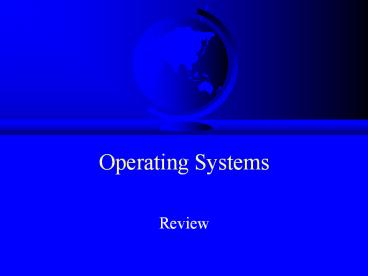Operating Systems PowerPoint PPT Presentation
Title: Operating Systems
1
Operating Systems
- Review
2
Outline
- Intro
- What is an OS, OS History
- Operating System Concepts
- Processes, Files, System Calls, Shells
- Operating System Structure
- Simple Systems, Virtual Machines Micro Kernels
- Processes
3
True or False
- Unix is a simple structure OS
- Micro Kernels are faster than other OSes
- Virtual Machines are faster than other OSes
4
Questions
- What are two functions of an OS?
- What layer is above the OS?
- What layer is below the OS?
5
Questions
- What causes OS to change?
- Or, why arent we still running MS-DOS?
- What is a process?
- What is a file?
6
Questions
- What is a PCB?
- List steps that occur during interrupt
- What is (average) waiting time?
7
Questions
- Explain how SJF works
- True or False
- FCFS is optimal in terms of avg waiting time
- Most processes are CPU bound
- The shorter the time quantum, the better
8
Review
- What is Petersons Solution?
- What does Test_and_Set do?
- What is one major advantage of semaphores over
the above two?
9
Possible Outputs?
- int main()
- int num, shm_id
- shm_id shmget(502)
- num (int ) shmat(shm_id)
- num num 1
- printf("d\n", num)
(Assume shm is 0 when first Created)
10
Review
- What is a relocation register?
- What are some of the sections in an object
module? - What are some of the steps that occur during
linking?
11
Review
- What is the Memory Management Unit?
- What is external fragmentation?
- What is internal fragmentation?
12
True or False
- With paging, physical address spaces are
contiguous - With paging, logical address spaces are
contiguous - Paging reduces the size of the possible address
space used by a process
13
Review
- Does paging have fragmentation?
- No? Then why not?
- Yes? Then what kind?
- What are the overheads associated with paging?
- What is run-time, dynamic linking?
14
Review
- True or False
- The logical address space cannot be bigger than
the physical address space - Processes have big address spaces because they
always need them - Demand paging
- Is unrelated to basic paging
- Brings logical pages into physical memory when
requested by a process - Increases memory requirements for a system
- All of the above
- None of the above
15
Review
- Page faults
- What is a page fault?
- What does an OS do during a page fault?
- What is a Page Replacement Algorithm?
- What is Beladys Anomaly?
- How does the Optimal algorithm work?
- How does Enhanced Second Chance work?
- What is thrashing?
- How do we fix it?
16
Review
- What is a file descriptor?
- What information must it contain?
- What information might it contain?
17
Linked-List with Index
- How many files are there?
- How large are they?
- How many free blocks are there?
18
I-Node
i-node
- How many data blocks are there?
- If you added 3 more data blocks to the file, what
would happen?
62
77
Disk blocks
null
null
null
null
null
19
Review
- Directories
- In what way is a directory different than a file?
- In what way is a directory similar to a file?
- Aliases
- Describe a hard-link
- Describe a soft-link
- Free space management
- What are two common methods of keeping track of
free blocks?

